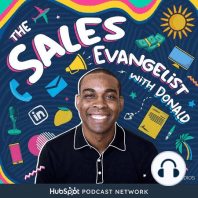27 min listen
TSE 1101: Forging An Ironclad Brand
ratings:
Length:
32 minutes
Released:
May 24, 2019
Format:
Podcast episode
Description
Your brand tells your story when you're not in the room, and today Lindsay Pedersen shares tips for forging an ironclad brand with sales reps, entrepreneurs, and other business professionals. Lindsay is a brand strategist who helps professionals identify the single idea that their business stands for. She's passionate about working with leaders to harness the power of brand every day. Branding Brand is what you stand for in the mind of your audience. If your audience is a group of customers, it's the thing you mean to your customers. If it's future employers, it's what you mean to them. It's a crystallized meaning of what you uniquely bring to your audience. [Tweet "When you stand for one idea, it's easier for your audience to grasp it than if you stand for multiple ideas. It's easier for a person to let one idea in. #branding"] When you spray a bunch of ideas out, it's harder for your audience to understand. It's in our interest for our audience to be able to understand because they'll be more like to remember us, like us, and talk about us. It's up to us to make it easy by distilling it for them. Empathy We want to empathize and understand what it's like to be our customer. You and your company are not the center of the universe for that customer. They have many other things going on besides your value proposition. When you crystallize it into something specific, it uses their worldview rather than their worldview. It makes it easier for them to buy what you're selling. Sometimes as businesses, we forget that we're not selling to a machine or an inanimate object. We're selling to humans with joys, sorrows, scarcities, worries, and pride. When they feel seen they are more likely to bond with you and want to do business with you. Deconstructing brand One of Lindsay's motives for writing her book was people's widely varying definitions of brand. For some people, it's the name of the business. For others, it's the logo. Others assume it's related to marketing budget or television advertising. She concluded that the concept was becoming problematic, and she wanted to demystify it. There's some merit to all of those ideas, but she needed to bust the myths about what brand isn't. Otherwise, we'll keep having puzzling conversations where people aren't speaking the same language. 9 Criteria of ironclad brand Not all brand is created equally. You have a brand whether you deliberately created it or allowed it to be passively created. If you aren't actively choosing the meaning, you won't have the brand position you want to have. A brand needs to be big enough to matter to your customer. A brand must be narrow enough that you own it. Your brand must be asymmetrical so it uses your lopsided advantage to position you with your customer. Your brand must be empathetic enough to address a deeply relevant human need. It must be optimally distinct so it strikes a balance between being a familiar promise while also being novel. It's a balance between functional and emotional so that it's rationally meaningful to your customer but also emotionally resonant. Your brand must be a sharp-edged promise that is simple and singular. It must have teeth and be demonstrably true. Your brand must deliver on time, consistently, every time. Vision When you think of sharp objects as they relate to your vision, those things are easier to see. Your eyes have to do less work. Ease is good because when you ask less of your audience they are more likely to learn and remember. An example of this is the fact that people around the world associate the Volvo brand with safety. Same thing with Prius, because people think of fuel-efficient cars. Buick doesn't have this sharp edge in its branding. If you're the CEO of Buick, how do you feel when your audience doesn't know what your brand means? Who even is the audience? The Buick salespeople have to do much more work than the Volvo or Prius salespeople. Wide net We assume that if we can keep the d
Released:
May 24, 2019
Format:
Podcast episode
Titles in the series (100)
TSE 005: The Power of Follow Up with Judy Garmaise by The Sales Evangelist
